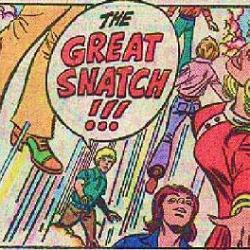Left Behind, pp. 28-30
From the pilot of a passing Concorde, Rayford Steele has learned that the mysterious disappearances on his plane are but a small piece of a global phenomenon. Finally Rayford picks up “an all-news radio outlet” that confirms the Concorde’s account.
One pictures Steele frantically scanning the dial looking for news — country music, hip-hop, oldies, adult contemporary — trying to find an “all-news” station in order to learn more about a global phenomenon bringing catastrophe, shock and sorrow to every corner of the globe.
Here, LaHaye and Jenkins may have stumbled onto an oddly accurate piece of prognostication. In the future, when Clear Channel’s conquest of the airwaves is near complete, most radio stations probably will be playing a nonstop loop of the same 10 songs on a continuous feed from the home office. These fully automated stations will have no local human personnel to break in with news when disaster strikes — as was demonstrated when Clear Channel’s stations failed to broadcast flood warnings in North Dakota. And in the story of Left Behind, it’s safe to assume that none of the executives at Clear Channel’s central office will have been “raptured,” so they would likely keep cranking out the Britney and Celine, unaware that anything was happening.
We can’t say that Rayford learns more details about the mass disappearances from the reports of this news station because, as usual, L&J don’t provide any of the details that would make this story interesting. This is a shame, since radio newscasts can be a particularly effective device for presenting glimpses of well-chosen detail that can heighten the sense of dread, suspense and foreboding — think of Orson Welles’ famous “War of the Worlds.” But L&J are not Welles, so instead we get more of the all-tell, no-show prose we’ve come to expect:
[Steele] learned the far-reaching effects of the disappearance of people from every continent. Communication lines were jammed. Medical, technical and service people were among the missing all over the world. Every civil service agency was on full emergency status, trying to handle the unending tragedies.
You almost have to admire L&J’s refusal to employ storytelling in telling this story. And it gets worse. Here’s Rayford’s attempt to come to grips with the scope of this tragedy:
Rayford remembered the El-train disaster in Chicago years before and how the hospitals and fire and police units brought everyone in to work. He could imagine that now, multiplied thousands of times.
Yes, it’s a global catastrophe — like a really, really big wreck on the El. Every infant and young child on the planet has disappeared (a detail L&J reveal in later pages), thousands are dead in hundreds of plane crashes — Rayford is right. That can only mean that EMTs won’t be getting their regularly scheduled time off.
Even the newscasters’ voices were terror filled, as much as they tried to mask it. Every conceivable explanation was proffered, but overshadowing all such discussions and even coverage of the carnage were the practical aspects. What people wanted from the news was simple information on how to get where they were going and how to contact their loved ones to determine if they were still around.
Readers of LB do not, of course, get to hear those newscasters’ voices. Nor do we learn here, or anywhere in the book really, what might be included in “every conceivable explanation.” And how to account for the strangely inhuman emphasis on the “practical aspects.”
L&J were writing in 1995, six years before the events of Sept. 11, 2001. But the news coverage of that event — and what viewers and listeners wanted from the news — followed the same general pattern of the coverage of earlier catastrophes, such as Kennedy’s assassination or Pearl Harbor.
The human questions that humans have in response to such events are the same questions reporters (and novelists) should always be in the business of answering: What happened? Who? What? When? Where? Why? How? Beyond that, faced with disaster and the loss of life, people also want to know: Who was responsible? Is it over? Will it happen again? Am I safe?
In the world of LB, no one seems to ask such questions. They just want to hear the next Shadow Traffic report. Such a bizarre perspective on human nature makes L&J bad novelists. It may even make them bad people.
L&J abruptly switch, mid-paragraph to Rayford’s instructions for landing and the logistics of his arrival at O’Hare. One assumes that these instructions are coming from air traffic controllers and not the all-news radio station, although the latter is what the text seems to suggest:
… Rayford was instructed to get in a multistate holding pattern that would allow him to land at O’Hare at a precise moment. Only two runways were open, and every large plane in the country seemed headed that way. Thousands were dead in plane crashes and car pileups. Emergency crews were trying to clear expressways and runways, all the while grieving over loved ones and coworkers who had disappeared. One report said that so many cabbies had disappeared from the cab corral at O’Hare that volunteers were being brought in to move the cars that had been left running with the former drivers’ clothes still on the seats.
Cars driven by people who spontaneously disappeared had careened out of control, of course. The toughest chore for emergency personnel was to determine who had disappeared, who was killed, and who was injured, and then to communicate that to the survivors.
Wrecked planes litter the runways, black smoke still rising with the scent of burning flesh. But far, far worse — the disappearance of cabbies has created an intolerable backup in the pickup lanes outside of baggage claims. Heroic volunteers, watching this tragedy unfold, refuse to sit idly by in the face of such suffering. They shrug off their personal losses on this day of horror, then brave great dangers and struggle to the airport against all odds so that, yes, they can get those unmanned taxis out of the way and get the line moving again!
[post-pub edited to add LB tag and fix typos]












